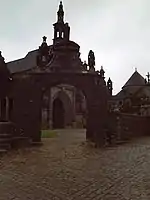Guimiliau
Guimiliau (Breton: Gwimilio) is a commune in the Finistère department of Brittany in north-western France.
Guimiliau
Gwimilio | |
|---|---|
 Parish close | |
Location of Guimiliau 
| |
 Guimiliau  Guimiliau | |
| Coordinates: 48°29′19″N 3°59′45″W | |
| Country | France |
| Region | Brittany |
| Department | Finistère |
| Arrondissement | Morlaix |
| Canton | Landivisiau |
| Intercommunality | Pays de Landivisiau |
| Government | |
| • Mayor (2014–2020) | Louis Fagot |
| Area 1 | 11.22 km2 (4.33 sq mi) |
| Population (2017-01-01)[1] | 1,009 |
| • Density | 90/km2 (230/sq mi) |
| Time zone | UTC+01:00 (CET) |
| • Summer (DST) | UTC+02:00 (CEST) |
| INSEE/Postal code | 29074 /29400 |
| Elevation | 63–159 m (207–522 ft) |
| 1 French Land Register data, which excludes lakes, ponds, glaciers > 1 km2 (0.386 sq mi or 247 acres) and river estuaries. | |
It is noted for the Guimiliau Parish close. It should not be confused with the neighbouring commune and village of Lampaul-Guimiliau.
Population
Inhabitants of Guimiliau are called in French Guimiliens.
| Year | 1793 | 1800 | 1806 | 1821 | 1831 | 1836 | 1841 | 1846 | 1851 | 1856 |
|---|---|---|---|---|---|---|---|---|---|---|
| Population | 1841 | 1557 | 1328 | 1397 | 1464 | 1495 | 1590 | 1596 | 1530 | 1497 |
| Year | 1861 | 1866 | 1872 | 1876 | 1881 | 1886 | 1891 | 1896 | 1901 | 1906 |
|---|---|---|---|---|---|---|---|---|---|---|
| Population | 1625 | 1625 | 1521 | 1523 | 1526 | 1511 | 1584 | 1562 | 1516 | 1453 |
| Year | 1911 | 1921 | 1926 | 1931 | 1936 | 1946 | 1954 | 1962 | 1968 | 1975 |
|---|---|---|---|---|---|---|---|---|---|---|
| Population | 1461 | 1275 | 1156 | 1043 | 949 | 988 | 818 | 786 | 756 | 700 |
| Year | 1982 | 1990 | 1999 | 2008 |
|---|---|---|---|---|
| Population | 760 | 791 | 814 | 943 |
Local Saints
Guimiliau, or Gwimilio in Breton, is named after St Miliau. The name simply means town or settlement (Breton: gwic) of Milio. According to legend, Miliau was a good and just Breton prince, put to death in a dynastic quarrel in the 6th or 9th century.
Guimiliau is also famous as the reputed birthplace of St Hervé, a 6th-century ascetic, who is one of the most popular Breton saints.
Parish close

Parish closes are a distinctive feature of Breton culture in the historic Léon diocese, in which Guimiliau stands. As the name suggests, a close is a completely enclosed church yard, usually with a commanding entrance arch. Sacred enclosures were a feature of Celtic religion even before the arrival of Christianity. Parish closes today form the foci for pardons, the annual Breton pilgrimage festivals, which can attract thousands of worshippers.
The parish close of Guimiliau is situated at the upper end of the main village street, with the entrance dominating the village.
The calvary or crucifix is the centre piece of the church yard, surrounded by a fine and complex retelling of the Passion in statuary. See Calvary at Guimiliau
The church contains many fine examples of polychrome sculpture from the sixteenth century onwards, including several large retables. There is also a fine octagonal baptistery, a carved pulpit and a collection of banners used especially in religious processions at pardons.
Gallery
 Church and Calvary.
Church and Calvary. Porch left side.
Porch left side. Porch right side.
Porch right side. Nave and choir.
Nave and choir.
 Detail from Retable of St Miliau.
Detail from Retable of St Miliau. Banner of the Blessed Virgin Mary.
Banner of the Blessed Virgin Mary. Detail of the carved pulpit.
Detail of the carved pulpit. Oak carved baptistry.
Oak carved baptistry. Carvings of birds, snakes and vines on the baptistery pillars.
Carvings of birds, snakes and vines on the baptistery pillars. Medieval carving in the porch of the church.
Medieval carving in the porch of the church.

 Dallam organ.
Dallam organ.
References
- "Populations légales 2017". INSEE. Retrieved 6 January 2020.
External links
| Wikimedia Commons has media related to Guimiliau. |
- Base Mérimée: Search for heritage in the commune, Ministère français de la Culture. (in French)
- Mayors of Finistère Association (in French)